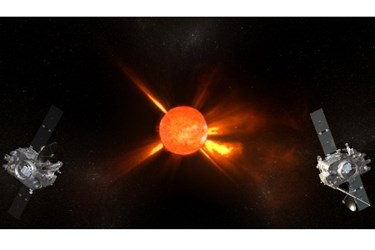Electron Beams And Radio Signals From The Surface Of The Sun

The sun emits light, but it also emits particle beams. A scientist at the Swedish Institute of Space Physics (IRF) in Uppsala has revealed how these beams generate radio waves. These radio waves can tell us about the outer layers of the sun and the interstellar medium without going there. In particular, the radio emissions are produced in small packages, and their shapes are determined by the density changes in the solar wind.
"We have known for a long time that the sun can produce electromagnetic emissions at the same frequencies as ordinary radio stations on Earth. If we can understand how these radio emissions are produced they could be used to probe the outer layers of the sun and interstellar medium, without going there, just by observing the natural radio signals," says Daniel Graham, an Australian scientist now working at IRF. The results are presented in the important physics journal Physical Review Letters.
The NASA Solar TErrestrial RElations Observatory (STEREO) mission, launched in 2006, consists of two spacecraft which orbit the sun, one ahead of Earth and the other behind Earth. These spacecraft have better instruments than previous satellites for observing waves.
Electron beams emitted from the sun are the start of a multi-stage process generating these radio waves. The electron beams travel out into the solar wind and generate a type of wave that cannot travel very far (electrostatic Langmuir waves). These waves can then generate natural radio waves, and these can be seen at Earth.
"This might provide us with information about the outer layers of the sun and the solar wind," says Daniel Graham, "but only if we understand all steps producing these radio signals."
Daniel Graham has used observations by STEREO where Langmuir waves were naturally converted into radio waves. These data might help us understand how information was transferred from the outer layers of the sun, to the electron beam, then into Langmuir waves, which are converted to radio waves and eventually reach Earth. This has to be done in space, since only the radio signals (as opposed to the Langmuir waves) can reach the surface of the Earth.
About The Swedish Institute of Space Physics (IRF)
The Swedish Institute of Space Physics (IRF) is a governmental research institute which conducts research and postgraduate education in atmospheric physics, space physics and space technology. Measurements are made in the atmosphere, ionosphere, magnetosphere and around other planets with the help of ground-based equipment (including radar), stratospheric balloons and satellites. IRF was established (as Kiruna Geophysical Observatory) in 1957 and its first satellite instrument was launched in 1968. The head office is in Kiruna (geographic coordinates 67.84° N, 20.41° E) and IRF also has offices in Umeå, Uppsala and Lund.
Source: The Swedish Institute of Space Physics (IRF)
